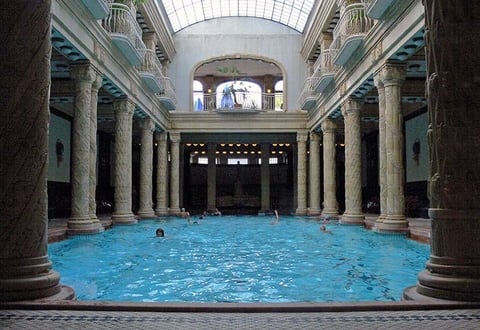Europe has a long and intriguing history. The vestiges of powerful ancient civilizations and a mosaic of diverse cultures combine in an alluring mix for history-loving travelers. From UNESCO World Heritage sites to glorious cathedrals and palaces, there’s an embarrassment of riches to discover. Travel through the centuries by exploring these must-see European landmarks.
Belfort (Bruges, Belgium): Rising 272 feet above the market square in the heart of Bruges, the bell tower is a striking symbol of the “Venice of the North.” Climb the 366 steps to admire views of the church spires, rooftops, and the canals guarded by white swans. You can also see the keyboard used by the city carillonneur to play the tower’s 47 carillon bells. Dating to the 13th century, the belfry of Bruges has been immortalized in poems, novels and Hollywood movies
Diocletian’s Palace (Split, Croatia): Back in 295 A.D., Roman emperor Diocletian had a mega-palace built for his retirement. Over the years, the high stone walls also served as military fortifications, enclosing the city complex and later its medieval cathedral. Diocletian’s Palace was classified a UNESCO World Heritage Site in 1979; today, a buzzing restaurant scene sprawls across the cobblestoned alleys within these ancient walls. The heart of the Dalmatian Coast, Split is also a popular base for exploring famous islands like Hvar, Brač, Vis and Korčula in the sparkling Adriatic Sea.
Gediminas’ Tower (Vilnius, Lithuania): The entire Old Town of Lithuania’s capital is a UNESCO World Heritage site, a buzzing and atmospheric city of baroque churches and cobblestone streets. Compact enough to explore by foot, the Old Town can also be appreciated from above—ascend the 158-foot Gediminas’ Tower, first built on the hilltop in the 13th century, to appreciate the cityscape panoramas.

Gellért Baths in Budapest, Hungary
Gellért Baths (Budapest, Hungary): No trip to Budapest is complete without a soak in one of the warm thermal baths. The city has been renowned for its healing waters since the Middle Ages and the spa experience is part of the social fabric. Arguably most famous among them is the Gellért Baths, built between built 1912 and 1918 as part of the Hotel Gellért. Designed in the Art Nouveau style with glass-domed ceilings, the complex has a series of pools and saunas, and also offers spa and medical services.
Neuschwanstein Castle (Bavaria, Germany): The perfect day trip from Munich, Neuschwanstein Castle was inspired by the romantic knights’ castles of the Middle Ages. It was commissioned by King Ludwig II as an homage to his friend Richard Wagner and construction began in 1869—a pharaonic project that cost a fortune and was never completed. But it’s an architectural treasure and the inspiration for Walt Disney’s Sleeping Beauty castle. Today, it draws awestruck tourists to a picturesque mountain setting.
Ostrog Monastery (Montenegro): Built into the sheer vertical cliffs of the Ostroška Greda ridge, roughly nine miles from Nikšić, the Ostrog Monastery is the most important Orthodox Christian site in the country and a place of pilgrimage. Founded in the 17th century as a cave-church, the complex expanded and was renovated in the 20th century after a fire. Admire beautiful frescoes and the shrine to St. Basil.
Pena Palace (Sintra, Portugal): Just an hour from Lisbon, the UNESCO-listed town of Sintra is often likened to a fairy tale, its mystical, fog-draped landscapes peppered with castles, monasteries and palaces. With such a remarkable concentration of sites, it’s little wonder Sintra is a favorite tourist destination in Portugal. The hilltop Pena Palace, built in the 19th century as a summer residence for the royal family, is among Sintra’s most alluring places. An architectural confection in exuberant colors, it was built in an amalgam of styles, the palace interiors just as eye-catching as the exterior.

St. John’s Co-Cathedral // Photo by youaintseenme/iStock/Getty Images Plus/Getty Images
St. John’s Co-Cathedral (Valletta, Malta): With a strategic location in the Mediterranean Sea, Malta has been fought over for nearly 3,000 years, occupied by civilizations like the Phoenicians and coveted by pirates and explorers. In 1530, these islands became the home base for the Order of Saint John, founded during the Crusades to protect Christian pilgrims in the Holy Land. In the knights’ city of Valletta, the limestone cathedral is a must-visit landmark, its interior a showcase of high Baroque architecture. The vaulted ceilings are adorned with paintings and the floor is covered with the marble tombstones of 400 knights.
The Alhambra (Granada, Spain): One glimpse of Andalusia’s famous palace fortress and you’ll see why the Alhambra has inspired authors to wax poetic over the centuries. Against the backdrop of the Sierra Nevada mountains, this masterpiece of Islamic art and architecture invites visitors to stroll through gardens, courtyard fountains, archways and palace rooms with mosaic tiles, intricately carved doors and wood ceilings in geometric patterns. Needless to say, the Alhambra is one of Spain’s most beloved tourist destinations, so it’s important to book tickets online in advance.
Wieliczka Salt Mine (Poland): Nine miles southeast of Krakow lies a UNESCO World Heritage site that’s as mysterious as it is fascinating. Starting in the 13th century and continuing until 1996, rock salt was mined in the town of Wielicka. The thousands of miners who worked here left behind exquisitely sculpted chambers, statues, and churches like St. Kinga’s Chapel, lit by crystal chandeliers. An exquisite work of art in a unique subterranean setting.
Related Stories
Spain Reopening to All Vaccinated Travelers June 7
The Cotswolds: Thatched Kingdom of Quaint
Europe Is a Cornucopia of Nautical Delights for Maritime Buffs

